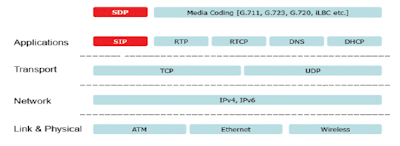Voice over IP
VoIP is transmission of analog voice as digital IP packets over packet-switched network.• Voice over IP is achieved by transmitting data from Application layer to Physical layer with
its own standards/protocols and transmission techniques for transmission of voice.
• Voice over IP has two phases: Call control and voice transmission:
* Call control is the mechanics of signalling the right user during initiation and termination of
call and billing the customer.
* Voice tranmission trasmits the voice signals to the destined user by coding of analog voice
to digital signal, packeting, adding the headers and on reaching the desitnation removing the
header, assembling the packets and decode the digital signal to analog voice.
Each of the process in both the phases mentioned above has its protocols and standards.
• When VoIP was introduced, VoIP calls were made between two PC intsalled with a VoIP
software.
 |
| Voice over IP |
being) introduced. Unlike PCs, each of these devices has its own subset of supported features
and provide extensive mobility support. This introduces two major challenges:
* VoIP interoperability between these devices from different vendors supporting different
features with/without propreitory standards.
* Identifying mobile devices/users during call initiation/while in a session.
 |
| Why SIP? |
Session Initiation Protocol
SIP or Session Initiation Protocol was developed to resolve these challenges - It is an Application-layer control peer-peer protocol for creating, modifying and terminating sessions with one or more participants in an IP-based network. SIP works on top of all the protocols from the internet protocol suite at the application layer for controlling peer-peer communication. SIP controls only session initiation and not a Session Description Protocol. SIP cannot work independently - it works with other protocols like RTP (for real time transmission of data), DNS (for identifying domains and users), DHCP (dynamic host configuration for mobile users), SDP (to describe the sessions), etc.
 |
| SIP in Internet Protocol Suite |
And here is how SIP has enabled VoIP between mobile/non-mobile devices with different features.
 |
| VoIP with SIP |
• SIP Components
* User Agents: User agents are applications installed on SIP endpoints such as an IP Phone, mobile phone, wireless device or PDA or a laptop or a desktop PC. When sending SIP requests, the UA acts as a user agent client (UAC), and when servicing a request, it acts as a user agent server(UAS).
* SIP Servers:
- Registrar: Authenticates and registers online users and stores information on the users' logical identities and the communications devices or physical entities (IP address) of the communications devices they can use
- Location Service: As users roam, the location service database that keeps track of users and their locations from registrar server. This information is used by proxy and redirect servers.
- Redirect Server: If users are not in their home domains/not reachable, redirect server maps a SIP request destined for a user to the URI of the device closest to the user.
- Proxy Server: A proxy server takes SIP requests, processes and pass them downstream while sending responses upstream to other SIP servers or devices. A proxy is involved only in the setup and teardown of a communication session.
- Presence Server: Presence servers accept, store and distribute presence information that allows users to see the availability of people they want to contact.

0 comments:
Post a Comment